This is an AI Free Zone: Text created by Large Language Models is spreading across the Internet. It's well-written, but frequently inaccurate. If you find a mistake on Spaceweather.com, rest assured it was made by a real human being.
|
|
|
SEVERE GEOMAGNETIC STORM--NOW! A severe (G4) geomagnetic storm is underway following the early arrival of two CMEs on Nov. 11th. Auroras have been photographed in the USA as far south as Florida, Texas and Alabama. If it is dark where you live, go out and look north for the geomagnetic glow. If you can't see anything, try taking a nighttime exposure using your smartphone. You might be surprised. Aurora alerts: SMS Text.
"This is possibly the brightest I’ve ever seen the auroras," reports Benjamin Root, who sends this photo from Atkins, Iowa:
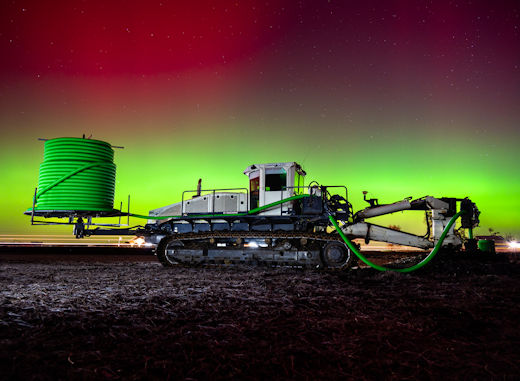
Root's photo raises a question: Is farm equipment going haywire? The last time there was a storm like this (May 2024), tractors acted like "they were demon possessed"-- a result of GPS errors. Farmers, if your GPS-guided equipment went off course on Nov. 11-12, let us know.
So far we're received aurora photos from more than 30 US states. Browse the gallery for the latest images.
Realtime Aurora Photo Gallery
Free: Spaceweather.com Newsletter
A 'GROUND LEVEL EVENT' IS UNDERWAY: Yesterday's X5-class solar flare from sunspot 4274 hurled a fusillade of energetic protons toward Earth. Some of the particles are so powerful, they are penetrating the atmosphere all the way to the ground. "This is a very significant event," says Professor Clive Dyer of the Surrey Space Centre. "Neutron monitors around the world are detecting it."
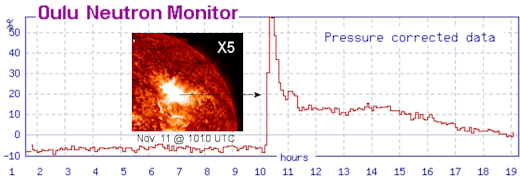
This is called a Ground Level Event (GLE). GLEs of this magnitude are rare; they happen only once or twice every solar cycle. "This one is comparable to the GLE of Dec. 13, 2006," says Dyer. That makes it a ~20-year event.
For comparison, during the 2006 GLE, passengers on high-latitude air flights experienced a peak dose rate of 25-30 microSieverts per hour at cruising altitude. This translated to an estimated 20% increase in the total effective radiation dose. Something similar may be happening now.
"Analysis of today's GLE will help us prepare for larger events such as a repeat of 23 February 1956, which is soon to have its 70th anniversary and gave a thousandfold increase in radiation at 40000 feet," says Dyer.
Meanwhile in space, the solar protons are peppering satellites, creating a hailstorm in imaging systems:
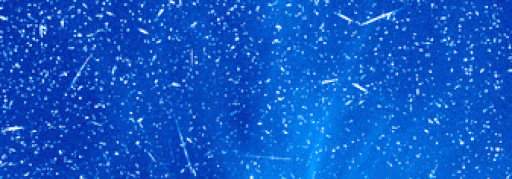
All of the 'snow' in this animation from SOHO's C3 coronagraph is caused by energetic particles striking the camera's CCD detector. Fogging of cameras is an important side-effect of strong radiation events.
Realtime Space Weather Photo Gallery
Free: Spaceweather.com Newsletter
A GIFT FOR TOLKIEN FANS -- THE ONE RING OVER HOBBITON: Need a Christmas gift for a Tolkien fan? Consider the One Ring over Hobbiton. During a rare South Pacific balloon flight, the students of Earth to Sky Calculus flew this ring to the stratosphere directly over the movie set for Peter Jackson's Lord of the RIngs:
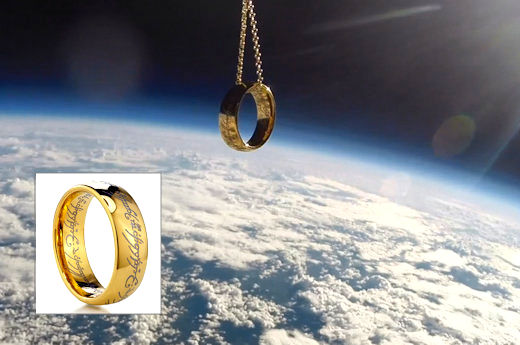
You can have it for $199.95. On the southern winter solstice, June 21st, it reached an altitude of 108,345 feet, flying alongide a suite of cosmic radiation sensors that the students use to monitor atmospheric radiation. The ring is made of gold-plated tungsten and inscribed with the authentic Mordor script of the One Ring.
Far Out Gifts: Earth to Sky Store
All sales support hands-on STEM education
Realtime Aurora Photo Gallery
Free: Spaceweather.com Newsletter
Every night, a network
of
NASA
all-sky cameras scans the skies above the United
States for meteoritic fireballs. Automated software
maintained by NASA's Meteoroid Environment Office
calculates their orbits, velocity, penetration depth
in Earth's atmosphere and many other characteristics.
Daily results are presented here on Spaceweather.com.
On Nov 10, 2025, the network reported 15 fireballs.
(10 sporadics, 5 Northern Taurids)
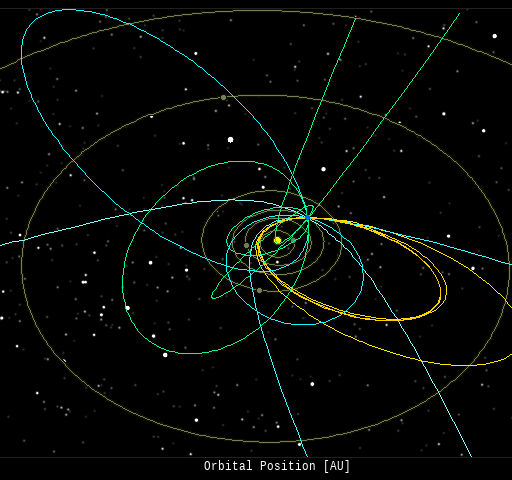
In this diagram of the inner solar system, all of the fireball orbits intersect at a single point--Earth. The orbits are color-coded by velocity, from slow (red) to fast (blue).
[Larger image] [movies]
Potentially Hazardous Asteroids (
PHAs)
are space rocks larger than approximately 100m that
can come closer to Earth than 0.05 AU. None of the
known PHAs is on a collision course with our planet,
although astronomers are finding
new
ones all the time.
On November 12, 2025 there were 2349 potentially hazardous asteroids.
 |
Recent
& Upcoming Earth-asteroid encounters:
| Asteroid |
Date(UT) |
Miss Distance |
Velocity (km/s) |
Diameter (m) |
| 2025 UP11 |
2025-Nov-06 |
6.5 LD |
5.1 |
8 |
| 2025 UO8 |
2025-Nov-06 |
17.9 LD |
7.2 |
33 |
| 2007 VU83 |
2025-Nov-07 |
13.5 LD |
10 |
31 |
| 2025 UN11 |
2025-Nov-07 |
9 LD |
6.7 |
10 |
| 2025 UL4 |
2025-Nov-07 |
16.8 LD |
8.2 |
25 |
| 2025 VN |
2025-Nov-08 |
0.1 LD |
11.9 |
9 |
| 2021 VQ10 |
2025-Nov-08 |
9 LD |
15 |
13 |
| 2025 VS |
2025-Nov-08 |
4 LD |
11.2 |
21 |
| 2025 VQ |
2025-Nov-08 |
4.9 LD |
12.6 |
25 |
| 2025 VY |
2025-Nov-08 |
5.4 LD |
13.8 |
13 |
| 2025 VU |
2025-Nov-08 |
7 LD |
6.3 |
17 |
| 2019 UH7 |
2025-Nov-08 |
13.3 LD |
5.8 |
11 |
| 2025 VB1 |
2025-Nov-08 |
2.3 LD |
20 |
19 |
| 2025 UL17 |
2025-Nov-08 |
5.9 LD |
9 |
36 |
| 2018 KC |
2025-Nov-09 |
16 LD |
9.3 |
11 |
| 2017 WG14 |
2025-Nov-09 |
16.7 LD |
11.7 |
45 |
| 2025 VA1 |
2025-Nov-09 |
0.7 LD |
14.2 |
9 |
| 2025 VR |
2025-Nov-10 |
2.8 LD |
10.8 |
15 |
| 2025 VT |
2025-Nov-10 |
9.1 LD |
5.2 |
26 |
| 2025 VK1 |
2025-Nov-10 |
9.6 LD |
15.2 |
13 |
| 2020 VK4 |
2025-Nov-10 |
16.4 LD |
3.8 |
9 |
| 2025 VX |
2025-Nov-11 |
1.2 LD |
6.4 |
14 |
| 2012 VC26 |
2025-Nov-11 |
13.3 LD |
6.4 |
6 |
| 2025 UP9 |
2025-Nov-11 |
18.1 LD |
14 |
46 |
| 2025 VW |
2025-Nov-12 |
5.4 LD |
7.1 |
16 |
| 2025 VR1 |
2025-Nov-13 |
3.1 LD |
8.1 |
11 |
| 2025 US11 |
2025-Nov-14 |
12.7 LD |
8.1 |
21 |
| 2019 VL5 |
2025-Nov-14 |
14.7 LD |
9.1 |
24 |
| 2025 VD1 |
2025-Nov-14 |
3.4 LD |
6.6 |
14 |
| 2025 VS1 |
2025-Nov-14 |
4 LD |
9.8 |
17 |
| 2025 VN1 |
2025-Nov-16 |
4.6 LD |
10.7 |
20 |
| 2022 FG4 |
2025-Nov-17 |
18.7 LD |
22.2 |
105 |
| 2025 VP1 |
2025-Nov-17 |
1.5 LD |
8.2 |
12 |
| 3361 |
2025-Nov-19 |
14.8 LD |
9.1 |
439 |
| 2013 NJ4 |
2025-Nov-20 |
12.6 LD |
6.4 |
12 |
| 2025 VO1 |
2025-Nov-21 |
2.6 LD |
9.4 |
17 |
| 2021 WR |
2025-Nov-22 |
19.3 LD |
10 |
31 |
| 516155 |
2025-Nov-24 |
12.5 LD |
16.7 |
338 |
| 2020 WM |
2025-Nov-24 |
17.4 LD |
11.8 |
36 |
| 2019 UT6 |
2025-Nov-25 |
6.2 LD |
12.6 |
146 |
| 2018 WG2 |
2025-Nov-27 |
13.5 LD |
7.5 |
3 |
| 2007 VM184 |
2025-Dec-01 |
13.1 LD |
20 |
219 |
| 2018 WC2 |
2025-Dec-03 |
9.8 LD |
8.9 |
36 |
| 2025 UF10 |
2025-Dec-04 |
14.5 LD |
13.2 |
132 |
| 2021 JE1 |
2025-Dec-08 |
13.5 LD |
7.1 |
16 |
| 2019 XN3 |
2025-Dec-10 |
5.7 LD |
3.6 |
15 |
| 1999 SF10 |
2025-Dec-10 |
8.2 LD |
4.4 |
46 |
| 2016 YH |
2025-Dec-13 |
6.8 LD |
8.9 |
28 |
| 2025 TZ |
2025-Dec-15 |
17.8 LD |
6.2 |
53 |
| 2015 XX168 |
2025-Dec-18 |
4.7 LD |
11.6 |
27 |
| 2010 WR7 |
2025-Dec-20 |
19.5 LD |
8.3 |
71 |
| 2021 AB1 |
2025-Dec-28 |
10.2 LD |
12.3 |
16 |
| 2019 AU |
2025-Dec-30 |
19.3 LD |
2.8 |
16 |
| 2024 AV2 |
2025-Dec-30 |
17.9 LD |
7 |
17 |
| 2014 AF16 |
2026-Jan-04 |
9 LD |
9.6 |
34 |
| 2023 XM15 |
2026-Jan-07 |
15.2 LD |
6.9 |
51 |
Notes: LD means
"Lunar Distance." 1 LD = 384,401 km, the distance
between Earth and the Moon. 1 LD also equals 0.00256
AU.
| |
Cosmic Rays in the Atmosphere |
SPACE WEATHER BALLOON DATA: Almost once a week, Spaceweather.com and the students of Earth to Sky Calculus fly space weather balloons to the stratosphere over California. These balloons are equipped with sensors that detect secondary cosmic rays, a form of radiation from space that can penetrate all the way down to Earth's surface. Our monitoring program has been underway without interruption for 10 years, resulting in a unique dataset of in situ atmospheric measurements.
Latest results (Nov. 2024): Atmospheric radiation is sharply decreasing in 2024. Our latest measurements in November registered a 10-year low:
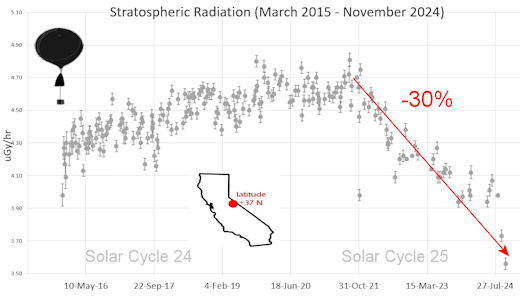
What's going on? Ironically, the radiation drop is caused by increasing solar activity. Solar Cycle 25 has roared to life faster than forecasters expected. The sun's strengthening and increasingly tangled magnetic field repels cosmic rays from deep space. In addition, solar coronal mass ejections (CMEs) sweep aside cosmic rays, causing sharp reductions called "Forbush Decreases." The two effects blend together to bring daily radiation levels down.
.Who cares? Cosmic rays are a surprisingly "down to Earth" form of space weather. They can alter the chemistry of the atmosphere, trigger lightning, and penetrate commercial airplanes. According to a study from the Harvard T.H. Chan school of public health, crews of aircraft have higher rates of cancer than the general population. The researchers listed cosmic rays, irregular sleep habits, and chemical contaminants as leading risk factors. A number of controversial studies (#1, #2, #3, #4) go even further, linking cosmic rays with cardiac arrhythmias and sudden cardiac death.
Technical notes: The radiation sensors onboard our helium balloons detect X-rays and gamma-rays in the energy range 10 keV to 20 MeV. These energies span the range of medical X-ray machines and airport security scanners.
Data points in the graph labeled "Stratospheric Radiation" correspond to the peak of the Regener-Pfotzer maximum, which lies about 67,000 feet above central California. When cosmic rays crash into Earth's atmosphere, they produce a spray of secondary particles that is most intense at the entrance to the stratosphere. Physicists Eric Regener and Georg Pfotzer discovered the maximum using balloons in the 1930s and it is what we are measuring today.
| |
The
official U.S. government space weather bureau |
| |
The
first place to look for information about sundogs,
pillars, rainbows and related phenomena. |
| |
Researchers
call it a "Hubble for the sun." SDO
is the most advanced solar observatory ever. |
| |
3D
views of the sun from NASA's Solar and Terrestrial
Relations Observatory |
| |
Realtime
and archival images of the Sun from SOHO. |
| |
information about sunspots based on the latest NOAA/USAF Active Region Summary |
| |
current counts of failed and deployed Starlink satellites from Jonathan's Space Page. See also, all satellite statistics. |
| |
Authoritative predictions of space junk and satellite re-entries |
| |
from
the NOAA Space Environment Center |
| |
fun to read, but should be taken with a grain of salt! Forecasts looking ahead more than a few days are often wrong. |
| |
from the NOAA Space Environment Center |
| |
the
underlying science of space weather |
 |
Got a chipped or cracked windshield that prevents you from seeing space weather events while driving? Get windshield replacement from SR Windows & Glass with free mobile auto glass service anywhere in the Phoenix area. |
| |
These links help Spaceweather.com stay online. Thank you to our supporters! |
|
|
| |
|
|
|